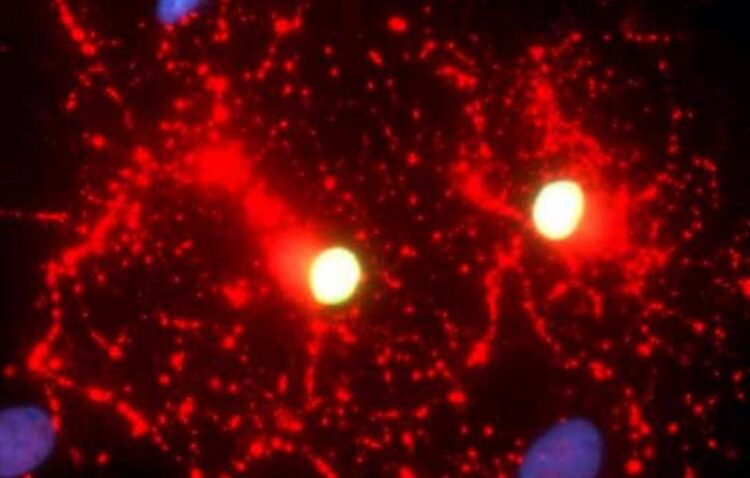Universal donor stem cell therapy to treat degenerative brain diseases

City of Hope's Yanhong Shi, Ph.D., and her colleagues engineered healthy human skin cells containing the functional aspartoacylase (ASPA) gene into induced pluripotent stem cells (iPSCs) and then differentiated the iPSCs into oligodendroglial progenitor cells, the precursor cells that produce myelin, an insulating sheath that wraps around nerve fibers. Like a bullet train, myelin sheaths facilitate the light-speed transport of information along neuronal axons.
Credit: City of Hope
The techniques used for this “off-the-shelf” solution can be extended to improve the quality of life for cancer patients facing debilitating side effects from chemotherapy and radiation therapy.
FINDINGS
Scientists at City of Hope, one of the largest cancer research and treatment organizations in the United States and a leading research center for diabetes and other life-threatening illnesses, have developed universal donor stem cells that could one day provide lifesaving therapy to children with lethal brain conditions, such as Canavan disease, as well as to people with other degenerative diseases, such as Alzheimer’s and multiple sclerosis. The study was recently published in Advanced Science.
“The off-the-shelf approach City of Hope is taking can easily be extended to improve the quality of life of cancer patients who are experiencing cognitive impairment or impaired motor function as a side effect of chemotherapy or radiation,” said Yanhong Shi, Ph.D., chair of the Department of Neurodegenerative Diseases and the Herbert Horvitz Professor in Neuroscience at Beckman Research Institute of City of Hope. Shi has been working on this research for 12 years.
SIGNIFICANCE
This is the first time stem cells have been engineered to become universal donors for cell therapy targeting diseases of the central nervous system, Shi said. This “off-the-shelf” approach can provide patients who need cell therapy with lifesaving treatments three to six months earlier.
BACKGROUND
Shi and her colleagues engineered healthy human skin cells containing the functional aspartoacylase (ASPA) gene into induced pluripotent stem cells (iPSCs) and then differentiated the iPSCs into oligodendroglial progenitor cells, the precursor cells that produce myelin, an insulating sheath that wraps around nerve fibers. Like a bullet train, myelin sheaths facilitate the light-speed transport of information along neuronal axons.
The treated Canavan disease animal models exhibited increased ASPA activity compared to the control mice and had a reduction in the toxic accumulation of the metabolite N-acetyl-L-aspartate (NAA) in the brain. Too much NAA has been linked to impaired motor function, mental deficiencies and premature death. As a result, the treated mice exhibited increased myelination and vastly improved motor function. Importantly, the universal donor cells were able to evade immune attack from the recipient mice.
While the previous technique her team established created a cell therapy from a patient’s own cells to avoid immune rejection, this new approach used techniques that allowed engineered hypoimmunogenic cells from a healthy donor to be transplanted into a humanized disease model without activating the immune system to kill the foreign therapeutic.
FUNDING
The study was supported by the California Institute for Regenerative Medicine (TRAN1-08525), the National Institute of Neurological Disorders and Stroke of the National Institutes of Health (NIH) (U01 NS122101), and the National Cancer Institute of the NIH (P30CA33572).
About City of Hope
City of Hope’s mission is to deliver the cures of tomorrow to the people who need them today. Founded in 1913, City of Hope has grown into one of the largest cancer research and treatment organizations in the U.S. and one of the leading research centers for diabetes and other life-threatening illnesses. City of Hope research has been the basis for numerous breakthrough cancer medicines, as well as human synthetic insulin and monoclonal antibodies. With an independent, National Cancer Institute-designated comprehensive cancer center at its core, City of Hope brings a uniquely integrated model to patients spanning cancer care, research and development, academics and training, and innovation initiatives. City of Hope’s growing national system includes its Los Angeles campus, a network of clinical care locations across Southern California, a new cancer center in Orange County, California, and treatment facilities in Atlanta, Chicago and Phoenix. City of Hope’s affiliated group of organizations includes Translational Genomics Research Institute and AccessHopeTM. For more information about City of Hope, follow us on Facebook, Twitter, YouTube, Instagram and LinkedIn.
Journal: Advanced Science
DOI: 10.1002/advs.202206910
Method of Research: Experimental study
Subject of Research: Animals
Article Title: Developing Hypoimmunogenic Human iPSC-Derived Oligodendrocyte Progenitor Cells as an Off-The-Shelf Cell Therapy for Myelin Disorders
Article Publication Date: 4-Jun-2023
Media Contact
Zen Logsdon
City of Hope
zlogsdon@coh.org
Cell: 626-409-9367
Original Source
All latest news from the category: Life Sciences and Chemistry
Articles and reports from the Life Sciences and chemistry area deal with applied and basic research into modern biology, chemistry and human medicine.
Valuable information can be found on a range of life sciences fields including bacteriology, biochemistry, bionics, bioinformatics, biophysics, biotechnology, genetics, geobotany, human biology, marine biology, microbiology, molecular biology, cellular biology, zoology, bioinorganic chemistry, microchemistry and environmental chemistry.
Newest articles

Innovative 3D printed scaffolds offer new hope for bone healing
Researchers at the Institute for Bioengineering of Catalonia have developed novel 3D printed PLA-CaP scaffolds that promote blood vessel formation, ensuring better healing and regeneration of bone tissue. Bone is…

The surprising role of gut infection in Alzheimer’s disease
ASU- and Banner Alzheimer’s Institute-led study implicates link between a common virus and the disease, which travels from the gut to the brain and may be a target for antiviral…

Molecular gardening: New enzymes discovered for protein modification pruning
How deubiquitinases USP53 and USP54 cleave long polyubiquitin chains and how the former is linked to liver disease in children. Deubiquitinases (DUBs) are enzymes used by cells to trim protein…



